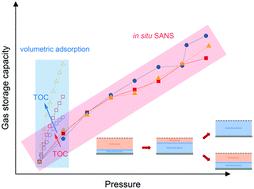当前位置:
X-MOL 学术
›
Environ. Sci.: Nano
›
论文详情
Our official English website, www.x-mol.net, welcomes your
feedback! (Note: you will need to create a separate account there.)
Unraveling high-pressure gas storage mechanisms in shale nanopores through SANS
Environmental Science: Nano ( IF 5.8 ) Pub Date : 2021-08-04 , DOI: 10.1039/d1en00419k Rui Zhang 1 , Shimin Liu 1 , Long Fan 1 , Tomasz P. Blach 2 , Guijie Sang 1
Environmental Science: Nano ( IF 5.8 ) Pub Date : 2021-08-04 , DOI: 10.1039/d1en00419k Rui Zhang 1 , Shimin Liu 1 , Long Fan 1 , Tomasz P. Blach 2 , Guijie Sang 1
Affiliation

|
As storage rocks rather than source rocks, shale reservoirs can potentially serve as energy storehouses for energy security and sequester CO2 in the long term to mitigate climate change. Despite extensive studies investigating the geochemical and geophysical properties of shale and gas adsorption and transport in the shale matrix, limited studies have been devoted to characterizing nanoscale gas storage mechanisms in shale at elevated high pressure. In this study, contrast-matching small-angle neutron scattering (SANS) has been conducted to quantify the gas storage mechanisms and capacity in three shale samples up to elevated high pressure using deuterated methane. The three-phase Porod invariant method is uniquely used to estimate the average scattering length density (SLD) in open pores over the measured pore range, in which open pores, closed pores, and rock matrix are the three phases. The estimated average SLD in open pores is smaller than the SLD of the bulk phase at the pressure between 10 MPa and the contrast-matched point (∼60–70 MPa, which is sample-dependent), while it is higher than that of the bulk at the pressure below 10 MPa and above the contrast-matched pressure, indicating a variation of average adsorbed phase density over the measured pressure range for the measured shale samples. The average adsorbed phase volume could first increase and then decrease with increasing pressure until the high-pressure region. Three essential factors, including the final injection pressure, total organic carbon (TOC), and accessible porosity, could be used to screen a potential targeted shale reservoir and maximize methane storage and long-term CO2 sequestration.
中文翻译:

通过 SANS 揭示页岩纳米孔中的高压储气机制
作为储油岩而不是烃源岩,页岩储层可以潜在地作为能源安全和封存 CO 2 的能源库从长远来看,减缓气候变化。尽管对页岩和气体在页岩基质中吸附和输运的地球化学和地球物理特性进行了广泛的研究,但很少有研究致力于表征高压下页岩中的纳米级储气机制。在这项研究中,已进行对比匹配小角度中子散射 (SANS) 以量化三个页岩样品的储气机制和容量,直至使用氘代甲烷升高高压。三相 Porod 不变性方法用于估计测量孔隙范围内开孔的平均散射长度密度 (SLD),其中开孔、闭孔和岩石基质是三相。在 10 MPa 和对比匹配点(~60-70 MPa,取决于样品)之间的压力下,开孔中估计的平均 SLD 小于体相的 SLD,而高于在低于 10 MPa 的压力和高于对比匹配的压力下,平均吸附相密度在测量的页岩样品的测量压力范围内发生变化。平均吸附相体积会随着压力的增加先增加然后减少,直到高压区。三个基本因素,包括最终注入压力、总有机碳 (TOC) 和可及孔隙度,可用于筛选潜在的目标页岩储层并最大限度地提高甲烷储存量和长期 CO 而在低于 10 MPa 和高于对比匹配压力的压力下,它高于块体的吸附相密度,表明测量的页岩样品在测量的压力范围内平均吸附相密度的变化。平均吸附相体积会随着压力的增加先增加然后减少,直到高压区。三个基本因素,包括最终注入压力、总有机碳 (TOC) 和可及孔隙度,可用于筛选潜在的目标页岩储层并最大限度地提高甲烷储存量和长期 CO 而在低于 10 MPa 和高于对比匹配压力的压力下,它高于块体的吸附相密度,表明测量的页岩样品在测量的压力范围内平均吸附相密度的变化。平均吸附相体积会随着压力的增加先增加然后减少,直到高压区。三个基本因素,包括最终注入压力、总有机碳 (TOC) 和可及孔隙度,可用于筛选潜在的目标页岩储层并最大限度地提高甲烷储存量和长期 CO 平均吸附相体积会随着压力的增加先增加然后减少,直到高压区。三个基本因素,包括最终注入压力、总有机碳 (TOC) 和可及孔隙度,可用于筛选潜在的目标页岩储层并最大限度地提高甲烷储存量和长期 CO 平均吸附相体积会随着压力的增加先增加然后减少,直到高压区。三个基本因素,包括最终注入压力、总有机碳 (TOC) 和可及孔隙度,可用于筛选潜在的目标页岩储层并最大限度地提高甲烷储存量和长期 CO2封存。
更新日期:2021-08-20
中文翻译:

通过 SANS 揭示页岩纳米孔中的高压储气机制
作为储油岩而不是烃源岩,页岩储层可以潜在地作为能源安全和封存 CO 2 的能源库从长远来看,减缓气候变化。尽管对页岩和气体在页岩基质中吸附和输运的地球化学和地球物理特性进行了广泛的研究,但很少有研究致力于表征高压下页岩中的纳米级储气机制。在这项研究中,已进行对比匹配小角度中子散射 (SANS) 以量化三个页岩样品的储气机制和容量,直至使用氘代甲烷升高高压。三相 Porod 不变性方法用于估计测量孔隙范围内开孔的平均散射长度密度 (SLD),其中开孔、闭孔和岩石基质是三相。在 10 MPa 和对比匹配点(~60-70 MPa,取决于样品)之间的压力下,开孔中估计的平均 SLD 小于体相的 SLD,而高于在低于 10 MPa 的压力和高于对比匹配的压力下,平均吸附相密度在测量的页岩样品的测量压力范围内发生变化。平均吸附相体积会随着压力的增加先增加然后减少,直到高压区。三个基本因素,包括最终注入压力、总有机碳 (TOC) 和可及孔隙度,可用于筛选潜在的目标页岩储层并最大限度地提高甲烷储存量和长期 CO 而在低于 10 MPa 和高于对比匹配压力的压力下,它高于块体的吸附相密度,表明测量的页岩样品在测量的压力范围内平均吸附相密度的变化。平均吸附相体积会随着压力的增加先增加然后减少,直到高压区。三个基本因素,包括最终注入压力、总有机碳 (TOC) 和可及孔隙度,可用于筛选潜在的目标页岩储层并最大限度地提高甲烷储存量和长期 CO 而在低于 10 MPa 和高于对比匹配压力的压力下,它高于块体的吸附相密度,表明测量的页岩样品在测量的压力范围内平均吸附相密度的变化。平均吸附相体积会随着压力的增加先增加然后减少,直到高压区。三个基本因素,包括最终注入压力、总有机碳 (TOC) 和可及孔隙度,可用于筛选潜在的目标页岩储层并最大限度地提高甲烷储存量和长期 CO 平均吸附相体积会随着压力的增加先增加然后减少,直到高压区。三个基本因素,包括最终注入压力、总有机碳 (TOC) 和可及孔隙度,可用于筛选潜在的目标页岩储层并最大限度地提高甲烷储存量和长期 CO 平均吸附相体积会随着压力的增加先增加然后减少,直到高压区。三个基本因素,包括最终注入压力、总有机碳 (TOC) 和可及孔隙度,可用于筛选潜在的目标页岩储层并最大限度地提高甲烷储存量和长期 CO2封存。











































 京公网安备 11010802027423号
京公网安备 11010802027423号